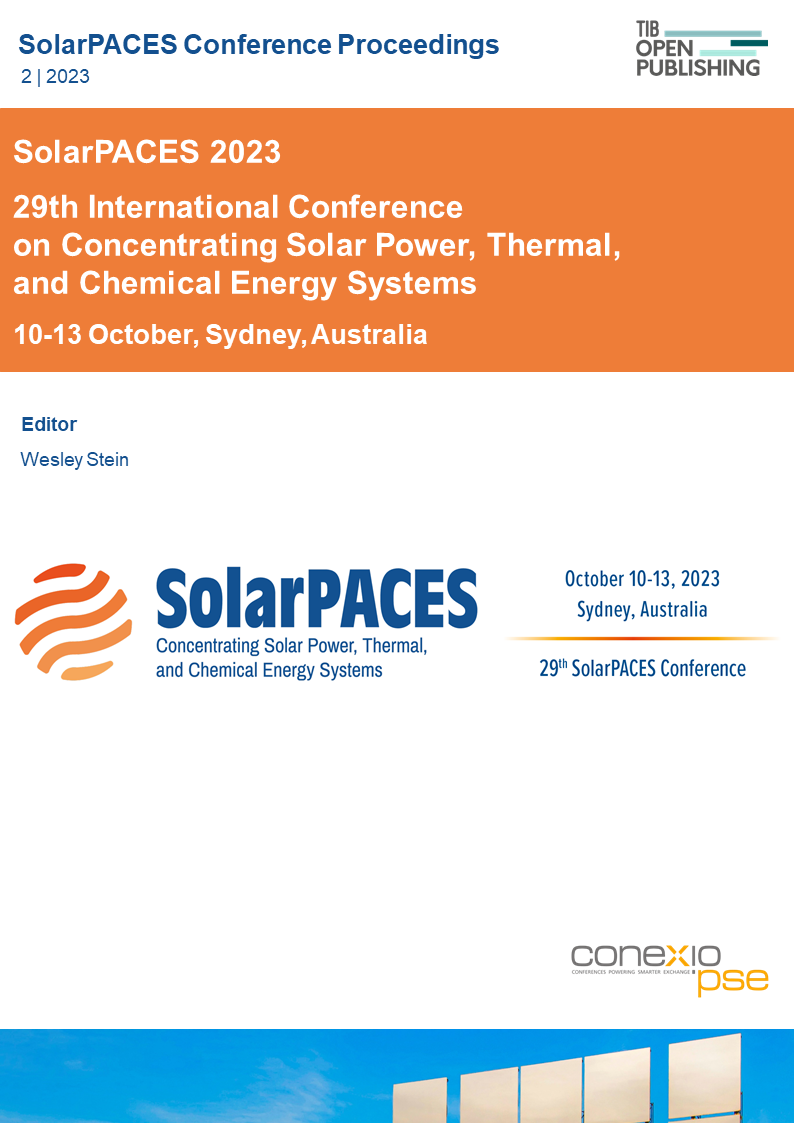Towards a More Efficient Design of High Temperature Concentrating Solar Power Plant With Cascaded Thermal Energy Storage
DOI:
https://doi.org/10.52825/solarpaces.v2i.780Keywords:
CSP, High-Temperature Configuration, Dual TES in CascadeAbstract
This work proposes a novel concentrating solar power (CSP) plant configuration aiming at a high operation temperature of 1000°C. The thermal energy storage system (TES) would be the focus of this research by modifying it and proposing four configurations to enhance the overall efficiency of high-temperature solar power towers. The objective is to identify the most thermodynamically efficient designs by analyzing the literature on the different components and comparing them to a reference base case of a conventional 100 MWe solar power tower plant (2-tank molten salt TES) operating at 565°C. The proposition consists of a Brayton/Rankine combined cycle with a double cascade TES. In the proposed cascade TES, the primary unit consists of a high-temperature air/ceramic packed-bed thermocline operating at 1000°C, while the secondary unit is a single molten salt tank used as sensible heat. The secondary TES is used as a heat sink during charge, improving efficiency and reducing the size of the air/ceramic-packed bed by extracting the thermocline out of the tank. Excess energy stored in the secondary TES is utilized for preheating during discharge. The methodology incorporates evaluating various combinations of solar block, TES, and power block integration. Combinations are selected from a comprehensive literature review. The study focuses on night-time operations. Further analysis of the cost-benefit of the designs would be required to compare the overall energy production and furthermore the LCOE.
Downloads
References
[1] “CSP Projects Around the World - SolarPACES.” Accessed: Aug. 29, 2022. [Online]. Available: https://www.solarpaces.org/csp-technologies/csp-projects-around-the-world/
[2] L. F. Nicolas et al., “Flexibility and robustness of a high-temperature air/ceramic ther-mocline heat storage pilot,” J Energy Storage, vol. 21, no. August 2018, pp. 393–404, 2019, doi: 10.1016/j.est.2018.11.034.
[3] C. S. Turchi, J. Vidal, and M. Bauer, “Molten salt power towers operating at 600–650 °C: Salt selection and cost benefits,” Solar Energy, vol. 164, pp. 38–46, Apr. 2018, doi: 10.1016/j.solener.2018.01.063.
[4] Z. Yang and S. V. Garimella, “Molten-salt thermal energy storage in thermoclines un-der different environmental boundary conditions,” Appl Energy, vol. 87, no. 11, pp. 3322–3329, 2010, doi: 10.1016/j.apenergy.2010.04.024.
[5] Q. Wang et al., “A review of eutectic salts as phase change energy storage materials in the context of concentrated solar power,” May 15, 2023, Elsevier Ltd. doi: 10.1016/j.ijheatmasstransfer.2023.123904.
[6] K. Jiang, X. Du, Y. Kong, C. Xu, and X. Ju, “A comprehensive review on solid particle receivers of concentrated solar power,” Renewable and Sustainable Energy Reviews, vol. 116, no. May, p. 109463, 2019, doi: 10.1016/j.rser.2019.109463.
[7] W. Steinmann, Thermal Energy Storage for Medium and High Temperatures. Springer Nature, 2022.
[8] K. Kulkarni, S. Havaldar, and N. Bhattacharya, “Review on advance tubular receivers for central solar tower system,” IOP Conf Ser Mater Sci Eng, vol. 1136, no. 1, p. 012018, Jun. 2021, doi: 10.1088/1757-899x/1136/1/012018.
[9] M. Ebert, D. Benitez, M. Röger, R. Korzynietz, and J. A. Brioso, “Efficiency determina-tion of tubular solar receivers in central receiver systems,” Dec. 01, 2016, Elsevier Ltd. doi: 10.1016/j.solener.2016.08.047.
[10] T. Conroy, M. N. Collins, and R. Grimes, “A review of steady-state thermal and me-chanical modelling on tubular solar receivers,” Renewable and Sustainable Energy Reviews, no. November 2018, p. 109591, 2019, doi: 10.1016/j.rser.2019.109591.
[11] A. L. Ávila-Marín, “Volumetric receivers in Solar Thermal Power Plants with Central Receiver System technology: A review,” Solar Energy, vol. 85, no. 5, pp. 891–910, May 2011, doi: 10.1016/j.solener.2011.02.002.
[12] B. Hoffschmidt et al., “Development of Ceramic Volumetric Receiver Technology,” 2002. Accessed: Jun. 30, 2024. [Online]. Available: chrome-extension://efaidnbmnnnibpcajpcglclefindmkaj/https://stobbe.com/media/10412/solair-from-1997-up-to-now.pdf
[13] H. Al-Ansary et al., “Study of the optimum discrete structure configuration in obstructed flow particle heating receivers,” in PROCEEDINGS OF THE 7TH INTERNATIONAL CONFERENCE ON ELECTRONIC DEVICES, SYSTEMS AND APPLICATIONS (ICEDSA2020), AIP Publishing, Dec. 2020, p. 030001. doi: 10.1063/5.0029145.
[14] A. Le Gal, B. Grange, R. Gueguen, M. Donovan, J. Y. Peroy, and G. Flamant, “Parti-cle flow and heat transfer in fluidized bed-in-tube solar receivers,” in AIP Conference Proceedings, American Institute of Physics Inc., Dec. 2020. doi: 10.1063/5.0028761.
[15] Y. Yu, F. Hu, F. Bai, and Z. Wang, “On-sun testing of a 1 MWth quartz tube bundle solid particle solar receiver,” Renew Energy, vol. 193, pp. 383–397, Jun. 2022, doi: 10.1016/J.RENENE.2022.05.036.
[16] J. García-Barberena, A. Olcoz, and F. J. Sorbet, “Advanced power cycles and config-urations for solar towers: Modeling and optimization of the decoupled solar combined cycle concept,” in AIP Conference Proceedings, American Institute of Physics Inc., Jun. 2017. doi: 10.1063/1.4984410.
[17] X. Chen, L. N. Sun, and S. Du, “Analysis and optimization on a modified ammonia-water power cycle for more efficient power generation,” Energy, vol. 241, p. 122930, Feb. 2022, doi: 10.1016/J.ENERGY.2021.122930.
[18] M. T. Dunham and B. D. Iverson, “High-efficiency thermodynamic power cycles for concentrated solar power systems,” 2014, Elsevier Ltd. doi: 10.1016/j.rser.2013.11.010.
[19] D. Alfani, T. Neises, M. Astolfi, M. Binotti, and P. Silva, “Techno-economic analysis of CSP incorporating sCO2brayton power cycles: Trade-off between cost and perfor-mance,” in AIP Conference Proceedings, American Institute of Physics Inc., May 2022. doi: 10.1063/5.0086353.
[20] W. H. Stein and R. Buck, “Advanced power cycles for concentrated solar power,” So-lar Energy, 2017, doi: 10.1016/j.solener.2017.04.054.
[21] “World first: Siemens Gamesa begins operation of its innovative electrothermal energy storage system.” Accessed: Oct. 01, 2023. [Online]. Available: https://www.sie mensgamesa.com/newsroom/2019/06/190612-siemens-gamesa-inauguration-en ergy-system-thermal
Downloads
Published
How to Cite
Conference Proceedings Volume
Section
License
Copyright (c) 2025 Brenda Hernandez Corona, Thomas Fasquelle, Muhammad Abdullah, Nicolas Lopez Ferber, Jean-Francois Hoffmann, Mathieu Martins, Ahmad Mayyas, Nicolas Calvet

This work is licensed under a Creative Commons Attribution 4.0 International License.
Accepted 2025-01-07
Published 2025-02-03
